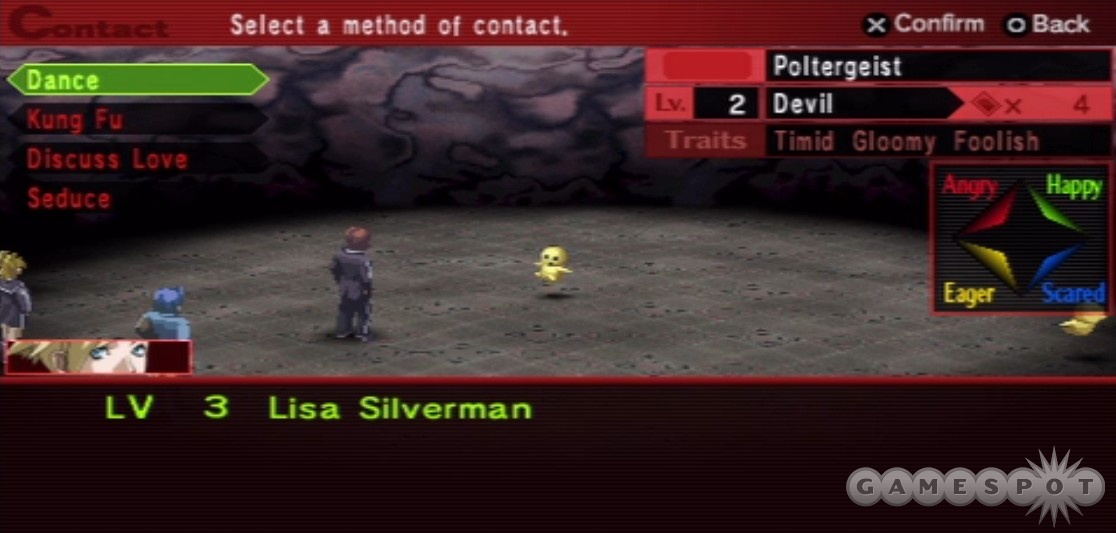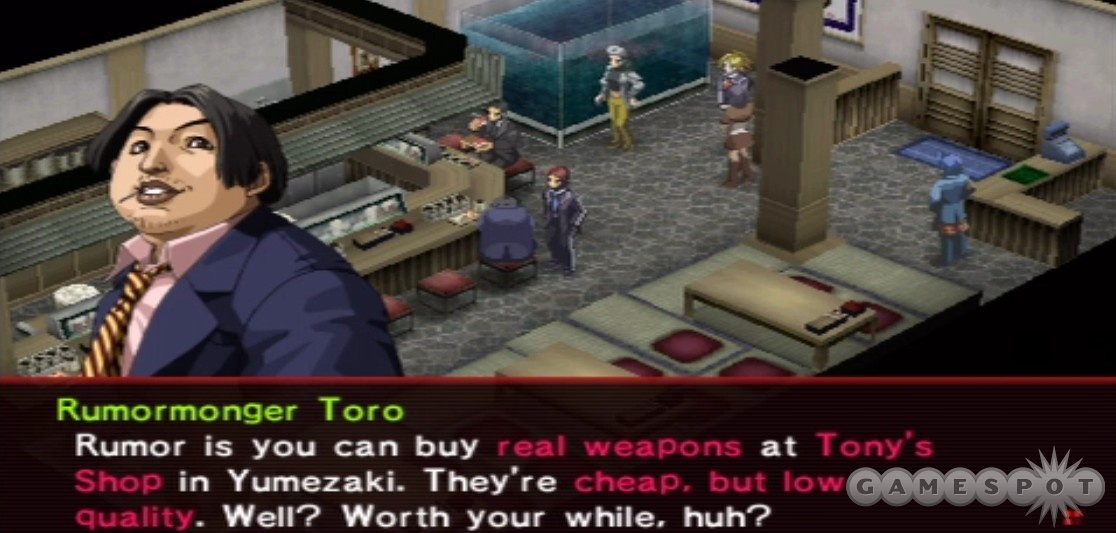The teenage years are a tumultuous time for many, but for Tatsuya Suou and the other young stars of Persona 2: Innocent Sin, being a teen is especially challenging. Not only do they have to deal with high school, the first pangs of romantic yearning, and all the other trials and tribulations that go with being a teen; they must also use their shared ability to summon powerful spirits called personas to help them defeat a mysterious evil force. When it was first released in Japan in 1999, Innocent Sin stood out from most role-playing games because of its contemporary setting and atypical cast of teen heroes. Now, the game is finally being released in the US, but alas, its time to shine has passed. By today's standards, the mechanics of this RPG are dull, repetitive, and outdated, and subsequent, superior releases in the Persona series offer more involving tales of modern-day teens faced with tremendous, otherworldly challenges. Today, Persona 2 is a bit like a former high school star quarterback whose best days are behind him.
As Persona 2 begins, strange things are afoot at Seven Sisters High School. The school's emblem has been cursed, and students are suffering from unusual, disfiguring ailments. Meanwhile, a dangerous new trend is spreading: teens are using their cell phones to summon Joker, a mysterious figure who might make your dreams a reality, or sap your soul and leave you a shadow of your former self. And on top of it all, any rumor that spreads to enough people in Sumaru City inexplicably becomes true. The pieces that make up the story's puzzle are interesting--ancient Mayans, aliens, and Adolf Hitler are all involved--but the story doles out new information much too slowly to make you feel invested in the early happenings. The shallow character sketches of somber Tatsuya, intense Michel, lovelorn Lisa, and the other party members aren't enough to make their quest feel personal or involving at first, and it's far too many hours into the game before you start learning more about this unlikely team of heroes. When you do, though, the characters reveal themselves to have fascinating connections, both to each other and to the events in which they're embroiled.
The fact that the game looks its age makes it less involving still. It wasn't a particularly attractive game in 1999, and the intervening years have not been kind. You view the action from an isometric perspective. The tiny characters express themselves with stiff shrugs and robotic shakes of the head. And although the high schools, record stores, aerospace museums, and other locations that serve as the "dungeons" for this RPG are a refreshing change of pace from the fantasy locales of so many games in the genre, these locations have no personality; one bland hallway is very much like another. Every once in a while, animated sequences are used to lend drama to a situation, but these are too infrequent to have much impact. The game fails to generate much tension in even the most desperate situations, such as a race to locate detonators for time bombs placed in various locations around the city.
Tedious, repetitive gameplay makes even inherently suspenseful situations like this one fall flat. As you explore a location, you're interrupted after every several steps by a random encounter with demons. The frequency of these encounters drags down the pace of the game, and the tiresome, menu-driven nature of the combat makes the battles a chore. At the start of an encounter, you can opt either to do battle with the demons or to attempt to communicate with them. Each member of your party has four different ways of making contact with these creatures. Tatsuya can "do impressions" and "discuss manliness," among other things, while Yukki has the abilities to "reason" and to "take photo" in her repertoire. If you say or do the right things, demons give you tarot cards, which you need in order to summon new personas. Initially, it's fun to see how demons respond to your different communication techniques, but it quickly stops being interesting. Once you learn that you can make a cockatrice hand over tarot cards by using Maya's "compliment" ability or that you can please a puck with Lisa's "kung fu" demonstration, the mystery is gone, and successful contact becomes a matter of just selecting an effective technique from the list again and again.

Of course, you don't want to talk your way out of every potential fight; you need to get experience killing things so that you can kill the tougher things you encounter later on. In battle, you can use physical attacks or call on your personas to cast spells that harm your enemies or benefit your party. As you use a persona, it gradually ranks up, giving you access to more spells. And some personas can work together to cast fusion spells, which, in addition to being powerful, are accompanied by attractive character portraits that depict the participating heroes with their hair blowing dramatically in the wind. But, like communicating with demons, battling them is generally a simple, repetitive matter of selecting the same effective options from menus again and again, and because these encounters happen with such frequency, this process quickly becomes a drag. You also have the option of triggering auto-battle, which makes the characters keep repeating your last selected actions until either the battle is over or you interrupt, but this option doesn't speed up the action. You still have to wait for every animation to play out, which is frustrating when you're tired of combat and just want to move on.
When you're not exploring one of the game's many dungeons, you move about the modern-day Japanese metropolis of Sumaru City on a map. Here, one of your most important occupations is gathering rumors from homeless people, fortune-tellers, and other rumormongers and employing the services of a detective agency to spread them, making them come true. But these aren't exciting rumors about buried treasure or even juicy high school gossip about who's dating whom; these are rumors about shops selling weapons and armor. You might get a hot tip that one shop sells poor weapons for cheap, for instance, or that another has high-quality armor, but the prices are high. Collecting and spreading these rumors is a dull process, and it's one you need to engage in repeatedly to have equipment that suits your party's level.
The PSP version introduces a movie theater you can visit to play two new side quests, so those who imported the original PlayStation release will find some new content here. But Innocent Sin wasn't hurting for content to begin with. The main story lasts a few dozen hours on its own, and there's no shortage of side quests you can complete that offer significant rewards for your party. But despite its length, the $40 price for a 10-year-old game whose visuals and mechanics make it a relic of a bygone era is much too steep. Diehard fans of the Persona series who are eager to experience every chapter in the saga might find that their enthusiasm enables them to overlook Innocent Sin's dated design, but those who are just in the market for a fun and satisfying RPG are much better off going with one of the more recent entries in the series. Though we might sometimes yearn to turn back the clock, we can't relive our teenage years, and we can't go back to 1999, when Persona 2: Innocent Sin was an exciting example of what an RPG could be.
